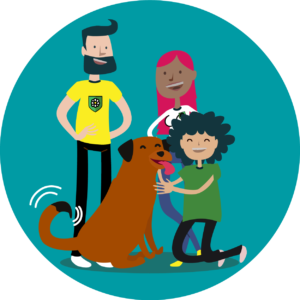Dogs bring joy and happiness to your life, but for children with diabetes, diabetic alert dogs save lives.
For Dorrie Nuttall, Jedi is a hero. The 75-pound black lab woke her from a sound sleep because her son Luke’s blood sugar levels were dropping quickly. Like other diabetic alert dogs, Jedi is trained to smell the spikes and drops in glucose levels.
Luke has Type 1 diabetes, an incurable autoimmune disease that could leave the seven-year-old in a coma if his glucose drops too low. Luke doesn’t experience symptoms, so he has to monitor his glucose constantly.
That’s one of the biggest dangers of this disease – it’s often asymptomatic. Extreme drops in glucose levels can lead to seizures or a coma – without any warning symptoms.
Luke’s story has appeared on major news networks and social media channels, but there are many stories like this.
Nine-year-old Kaeclin was in church when her black lab Charli noticed something wrong. Charli alerted Kaeclin’s dad to her dangerously low blood sugar, helping the family avoid a perilous situation.
TaterTot, a pit bull, barked and whined at Peyton’s mom to alert her of her son’s drop in blood sugar. The four-year-old was barely breathing. Thanks to TaterTot, he is alive and happy today.
Pets don’t just offer life-saving services; they give humans an emotional boost, too. Dogs bring joy and companionship into our lives. In the words of Peanuts’ creator Charles Schultz, “Happiness is a warm puppy.”
What you should know about diabetic alert dogs
- Be aware: there is no government licensing or industry oversight for diabetic alert dogs. Essentially, this is a buyer-beware field. Don’t worry too much, though; there is a lot of information online, making easy to find a reputable breeder.
- Diabetic alert dogs are service dogs. Your dog can go with you to restaurants, on the subway, or to school.
- Diabetic alert dogs are always working, but they’re still dogs. They need the care and attention that any animal would. Your dog will need visits to the vet, daily walks, and play time.
What to look for in diabetic alert dogs
There is no government oversight or accreditation for diabetic alert dogs, but there are ethical and honest trainers across the United States.
While some specifics may vary, here are a few guidelines for choosing a trainer or breeder:
- Scent training for a service dog can take many months, or even years, of continual work.

- You should be able to get a list of references from a trustworthy trainer or breeder.
- Look for positive online reviews.
- An organization should never claim that their dogs can replace glucose monitors. Well-trained service dogs may be amazingly accurate. However, breeders aren’t licensed to give medical advice.
- A reputable organization will offer continued in-home or in-person training for a period of time, so the dog and the new owner can learn to work together.
What do diabetic alert dogs do
Diabetic alert dogs smell the changes in a person’s chemistry, and notice subtle changes in blood sugar – in some cases, even before it registers on a monitor.
Dogs are trained to alert their owner or another family member of low or high blood sugar episodes. They may pick up a specific “signal” item, put their paw on your knee, or nudge you with their nose.
How much do diabetic alert dogs cost
Diabetic alert dogs can cost quite a bit due to the extensive training involved. The average price for an alert dog is between $15,000 and $20,000, and most families can’t afford them.
In some cases, insurance policies may cover part of the expense for a service dog. You can also deduct the cost of a service dog as a medical expense on income taxes, assuming you have the ability to pay for one outright. There are also nonprofit organizations that work to place service dogs with families at no cost.
Additionally, there are organizations, including Cameron’s Crusaders, who help families bridge the financial gap between insurance coverage and the expenses of care for their children.
We know from experience that there is no greater pain than having a sick child. We also know that insurance doesn’t cover financial burdens like your rent, mortgage, gas bills, or travel expenses. If you’re facing the challenge of paying for medical care for your child, get in touch with us. Help might be closer than you think.
Do you have a service dog? How has your life changed because of it? We’d love to hear your story.


